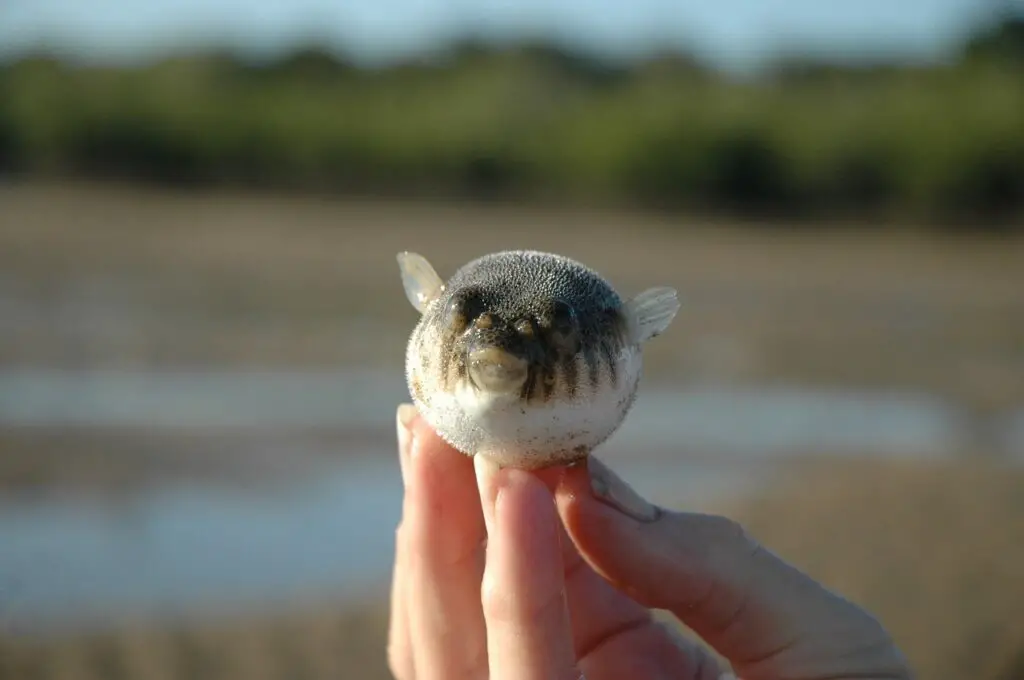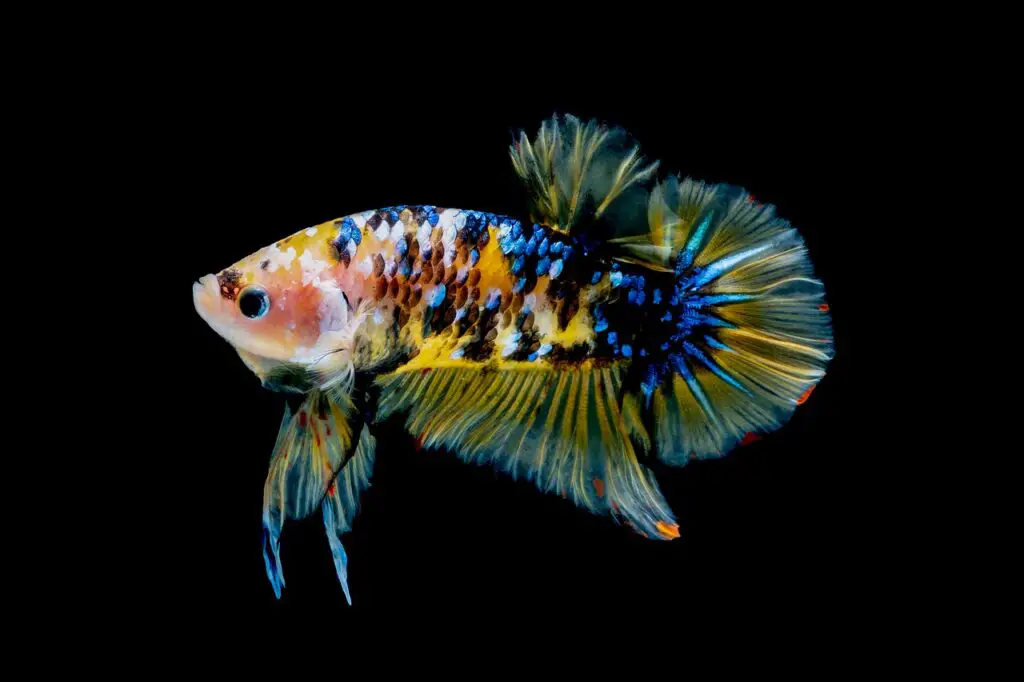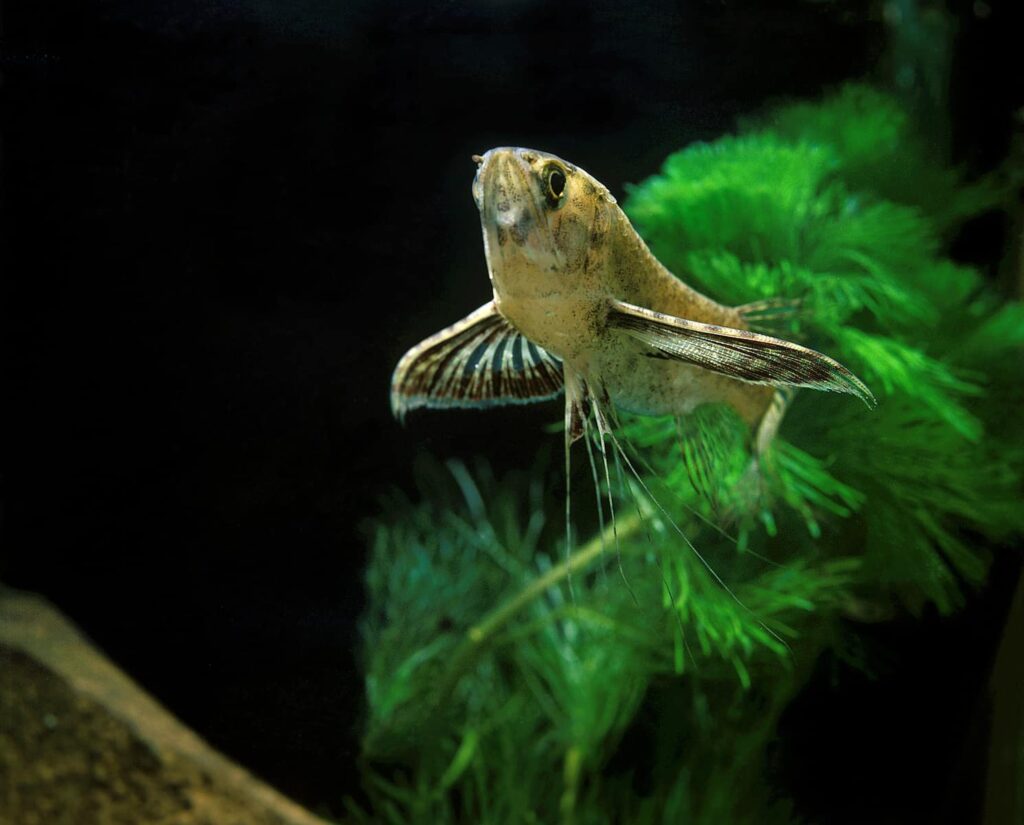Pufferfish care
An amazing variety of Pufferfish exist across the globe. Over 120 different species attract admiration – and sometimes fear – worldwide! These fish are fascinating but can pack a punch! As their name implies, they can self-inflate in response to threats.

Many people enjoy eating pufferfish as specialist dishes – but careful preparation of the fish is required because they can be poisonous to the extent of causing death! The poison, called Tetrodotoxin, is the reason chefs preparing these fish are trained in the art of identifying and treating them.
Pufferfish spines are extremely dangerous and can even cause death! Therefore, caution is always advised. There’s nothing to say you can’t enjoy watching them in your own brackish tank, however, providing you are careful!
- Fish Lifespan: Up to 10 Years
- Tank Size: At Least 10 Gallons
- Water Temperature: Between 74F and 78F
- pH: Between 7.0 and 7.6
- Hardness: Varies
- Compatibility: Compatible with Other Puffers (Occasionally!)
- Fish Size: Up to 24 Inches
How do you take care of Pufferfish?
Puffers are seriously interesting fish. They can even learn to recognise you, and spit water at the surface to indicate they are hungry!
Varying in size and colour, they require some special care and are not really suitable for novice keepers. There are over 120 species of Puffer, 30 of which live in freshwater. They come in all shapes and sizes and generally expensive to buy as well as tricky to breed.

Puffers have one of the most famous defensive mechanisms in the ocean. So much so, they can even be deadly to humans who try to eat them, too. That’s one reason why, on the whole, beginners shouldn’t really tangle with pufferfish unless they have explicit supervision.
A pufferfish can be aggressive and can need a variety of food in their diet. Therefore, if you do want to take care of puffers in your own brackish tank, you’re going to need to do some homework.
Ultimately, puffers are really rewarding to keep as pets. However, you are likely going to need to put plenty of work in of your own if you really want to ensure that you are giving them your best.
What fish can be kept with Puffers?
Puffers are aggressive fish. They are fin nibblers and punch against their weight when presented with bigger fish! Other fish can be brutally and fatally attacked by these beautiful demons and so it is usually advised to keep them alone.
They will require an interesting tank and a good food supply to keep them happy, but if you try to house other fish with them, they are likely to be injured and/or eaten!
They do eat their offspring, so, after a mating session, it is best to separate them and once hatched, it is best to separate the youngsters.
What size tank do you need for a Puffer Fish?
The size of tank best for your pufferfish really can vary. It all depends on the type and variation of puffer that you own.
Below is an example of the range of fish and tank sizes required to accommodate them! You will know what size tank suits your property and what is desirable for you in terms of upkeep.
- Red Tailed Dwarf Puffer – 10 gallons
- Dwarf Puffers – 10 gallons
- Imitator Puffer – 10 gallons
- Congo Puffer – 40 gallons
- South American Puffers – 40 gallons
- Crested Puffer – 55 gallons
- Golden Puffer – 125 gallons
- Bu Puffer – 500 gallons
There are many variations in between, and your fish supplier will guide you about tank size as well as water conditions.
Can you get freshwater Puffer fish?
Yes – you certainly can – and some pufferfish switch between brackish and freshwater habitats. It is best to seek advice about which of these suits your requirements and your supplier may have limited ability in acquiring and stocking a particular type of puffer.
Price can be an issue, too – and it is best to consider your budget and research accordingly. Puffers are highly sought after despite their defensive natures!
Are Puffer fish easy to keep?
Pufferfish are not the easiest of fish to keep and are therefore ideal for intermediate to experienced fish keepers. There are few reasons for this.
Freshwater pufferfish do not have scales and are susceptible to disease/ectoparasites. The Protozoa parasite lives on gills, fins and on the skin, for example. This is treatable but is best avoided – and clean living conditions can help you avoid the problem altogether.

If you source your fish from a reputable supplier, you should always purchase healthy fish – and as pufferfish require careful handling and observation, the best supplier will be an experienced fish keeper and give advice on treatment, should the need arise.
It is recommended that a good water filter is placed in your aquarium. Aside from general health, these fish produce a lot of waste matter and it is usually advised to replace 50% of the tank water on a weekly basis. Cloudy water is detrimental to health and cause other problems such as Ich disease.
Do Puffer fish bite humans?
Yes – they do – but more so in the wild and usually only when threatened. This is a rare occurrence, but pufferfish are some of the deadliest of aquatic creatures known – second only to the Poison Dart Frog.
They are known as pufferfish for a reason! They have a unique ability to inflate as part of their defence mechanism, too. Contrary to popular belief, they swell themselves up with water, not air. This increases their size and is when they can release a poison causing serious nerve damage to their opponent.
Humans can experience dizziness, nausea and some degree of paralysis, to in the
severest of cases, complete paralysis. In the wild, some species carry enough toxin to kill up to 30 adult humans! It should be noted that not all of the species are so deadly, but it is best to learn to recognise the potential of these fish when swimming with them!
Can you put 2 Puffer fish together?
Yes – and in fact, one male can safely house with up to three females. However, compatibility, even amongst the same species varies – and it is best to seek advice from your supplier.

It is usually recommended to only put pufferfish of the same species into the tank and sometimes only at breeding times, after which they should separate. They do sometimes consume their young and can become aggressive towards one another.
Larger tanks with more space facilitate greater harmony – but careful observation is recommended to watch for mood changes, and to also check for injuries if pufferfish share an aquarium.
Feeding your Pufferfish
Keeping your pufferfish happy, particularly as it is likely they will be living alone, means that you should focus on giving your critters as much variety as possible. As omnivores, you can feed live meat, such as other fish, shellfish and snails.
The latter are great to keep the teeth of your puffer from growing too long! If you don’t give them adequate hard material to chomp on, you may need to literally ‘trim’ their teeth. In the wild, they gnaw away on shellfish and other crustaceans, so it will be easier for you if you can supply enough of that coarse material. Otherwise, it can be daunting to have to deal with their teeth and advice should be taken by people new to this activity!
Pufferfish have two upper and two lower front teeth which gives them an interesting appearance – and a rare one for fish!
Dried or frozen food is great for your puffer, too, and of course as omnivores, they will enjoy some vegetable matter too.
Below is an idea about how frequently some puffers should be fed. This is based on the size of the fish.
- Small puffers should be fed daily.
- Medium sized puffers should be fed once every two days.
- Large puffers should be fed 2 to 3 times per week.
This is based on feeding a good mix of meat and vegetable matter, which for larger fish especially may mean the amount takes longer to devour, particularly when live fish are fed to them.
Should I get a Puffer Fish?
A pufferfish is always likely to be a big draw for your aquarium! However, puffers can take a lot of care and effort, and what’s more, they can be deadly.
That said, they are seriously charming in their own little way! They are real characters, and if you have the time to take care of them, definitely make a point of introducing them to your own brackish water.
However, you must make sure that you have some fish keeping experience behind you before you take a look at anything this exotic, or famously tricky!
Take a look at our other guides to brackish fish elsewhere, too. Puffers really only do well on their own – are you up to the challenge?



